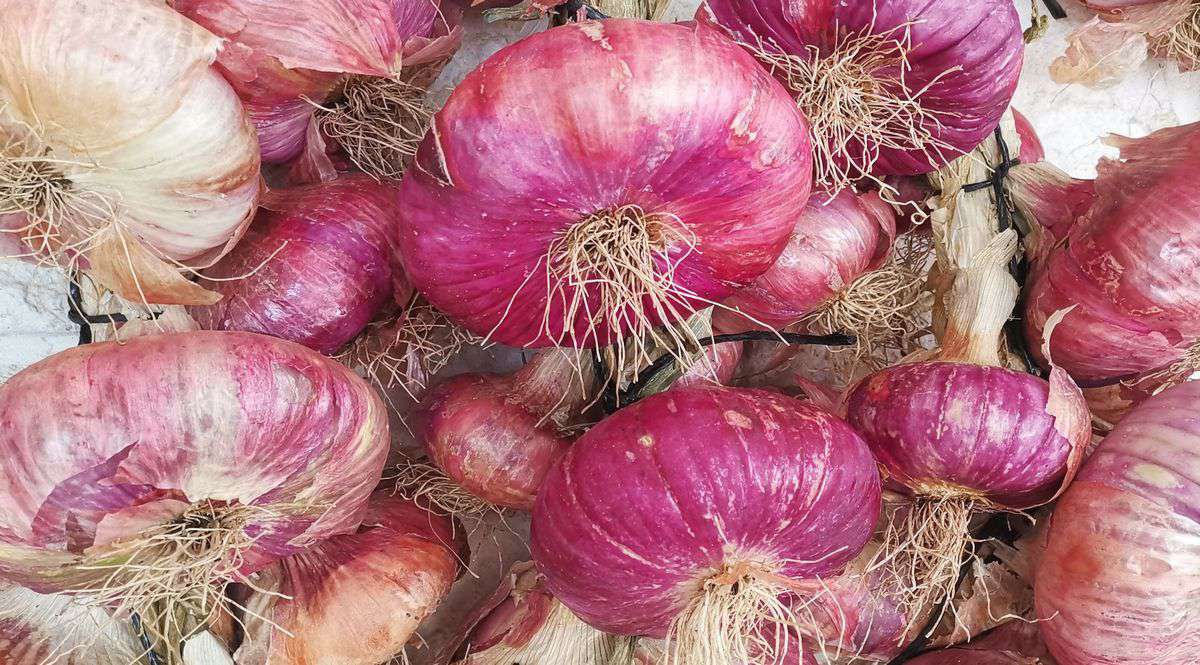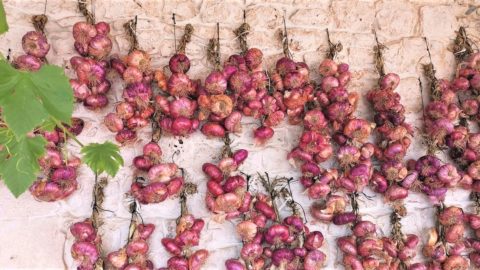“Il suolo è fertilissimo in olio, grano, anice, comino, mandorle, biade e legumi. Vuolsi notare che fra i ricolti, onde maggiormente si avvantaggia la classe agricola è quello delle cipolle, ricercatissime anche da lontane regioni, essendo prodotto speciale di una parte di questo suolo, che le rende preferibili a quante ne producono altri terreni”. La citazione è tratta da “Storia della Chiesa Palatina di Acquaviva delle Fonti dal 1779 al 1875″, testimonianza pubblicata nel 1875 della vocazione agricola di questa parte di territorio che fa parte della città metropolitana di Bari e famoso per la coltivazione della cipolla. Acquaviva delle Fonti è infatti legata all’ampia disponibilità di acqua dolce, che sgorga limpida da una falda sotterranea perenne: vi è poi la qualità dei terreni di questo angolo di Puglia, ben drenati ed aerati, profondi, ricchi in potassio, con un impasto medio, tendente a limoso.
Caratteristiche ideali per la coltivazione della tipica cipolla rossa, prodotto di presidio SlowFood. Rinomata per la sua dolcezza, la cipolla di Acquaviva è riconoscibile non solo per il colore ma anche per la tipica forma appiattita: un grosso disco dello spessore di 2-3 centimetri, largo fino ad una spanna, e con un peso di circa 500 grammi. Il suo colore sta, volendo essere precisi, tra il rosso carminio e il violaceo e si schiarisce, verso l’interno, sino a divenire completamente bianca. Anche la coltivazione avviene nel rispetto della tradizione antica e in modo del tutto naturale: seminata in settembre, a luna calante, la cipolla pugliese raccolta dai primi giorni di luglio sino ad agosto.
La coltivazione della cipolla d’Acquaviva è però limitata al territorio del Comune, e la sua coltivazione ancora manuale fa sì che la resa media per ettaro è molto inferiore alla media nazionale: 200 quintali contro i circa 300 quintali della media nazionale. Mantenendo al minimo gli interventi di tipo chimico, si rende necessaria una dose supplementare di lavoro in campo: le sarchiature e le scerbature (operazioni di diserbo manuale dei filari) devono essere frequenti e questo si riflette anche sul costo del prodotto finale. Il costo alto e le difficoltà di produzione hanno reso necessario il presidio di un’istituzione agroalimentare come SlowFood, soprattutto dopo che nell’ultimo periodo sono esponenzialmente aumentati i furti nei confronti di questi piccoli produttori locali, da parte di ladri che fiutano l’affare, visto che la cipolla rossa è un prodotto sempre più ricercato e pregiato.
“La cipolla rossa di Acquaviva è una risorsa importante per il territorio – spiega Marcello Longo, responsabile del Presidio SlowFood – e come tale dovrebbe essere difesa. Ancora una volta, è necessario che le istituzioni si mettano al fianco dei piccoli produttori e li aiutino a far fronte a questo enorme problema, ad esempio imponendo controlli su tutte le bolle delle merci che viaggiano nella regione o organizzando ronde delle forze armate che controllino i campi. In nome dell’impegno dei piccoli produttori del Presidio a garantire un prodotto di qualità, coltivato secondo i metodi tradizionali e un rigido disciplinare, anche la società dovrebbe non solo rispettare questo importante patrimonio, ma tutelarlo sotto ogni aspetto, compresa la sicurezza”.

LA RICETTA: CALZONE DI CIPOLLA ROSSA DI ACQUAVIVA DELLE FONTI
Per la pasta: farina, olio, sale acqua.
Per il ripieno: cipolla d’Acquaviva, ricotta forte (akuànde), uova, formaggio pecorino.
Preparazione: affettare finemente la cipolla e farla cuocere a fuoco lento con olio e sale in un tegame con coperchio fino a quando l’acqua delle cipolle si assorbe, far raffreddare la cipolla cotta e aggiungere la ricotta forte, uova e pecorino mescolando il tutto sino a ottenere un impasto omogeneo. Versare la farina a fontana e mettere al centro l’olio e un bicchiere di acqua tiepida. Lavorate gli ingredienti e impastate per 15 minuti circa. Dividere l’impasto in due parti e stenderle.
Ungere una teglia con un po’ d’olio e foderarla con la sfoglia tagliando le parti in eccesso. Versare all’interno il composto e livellarlo. Tirare la seconda parte di sfoglia e coprire la preparazione pizzicando bene i bordi. Cuocere in forno già caldo (180 °C) per circa un’ora.





